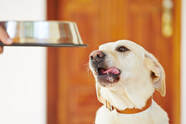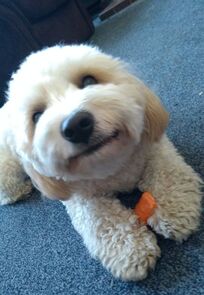 It wasn’t always the done, recommended thing to take your dog to training classes. But when it first became popular to take your companion dog to training, the standards that were set were taken mostly from the military. Some of those exercises are still practiced today at some classes; but perhaps we need to be asking ourselves, are these exercises really appropriate for us and our companion? If our dog is going to be a pet, do we really need to train them as we would a show dog, or a police dog, or a sheep dog? It is not always a positive experience for the dogs or the owners. Now let us be clear, nobody wants a badly behaved dog, aside from he stress it can cause a badly behaved dog that is out of control can be dangerous. So what training is useful to both the companion and their owners and what perhaps should be left to the ‘professional career dogs’?
 Then there is waiting to be fed! Sigh! This is a constant battle in our house every morning and evening. We have a child gate on our kitchen so we can keep them at bay whilst we get their meals ready. Now nobody wants to be knocked over as their dog dives for their bowl. I don’t see the benefit of making a dog wait unnecessarily for their food and it only seems to serve the humans need to exercise power over the dog simply because they can. There are some very old fashioned and dated training that would insist the dog be made to sit and wait for so long after the bowl is presented that is nothing more than teasing. You really don’t want your dog to find mealtime stressful, when that can lead to all sorts of other issues.  Teaching “Down” is another useful skill in keeping your dog still but only really works if they will stay in the down position whilst you deal with what ever it is that you need to do. This posture is also difficult for deep chested dogs, or those with injuries, sore hips, knees or elbows. So again, for those dogs its kinder to teach hem to stand. If you go to a dog friendly café, it is perfectly fine for a dog to lay out on their side if they find it more comfortable as long as they are not in anyone’s way. Most dogs will be fine to arrange themselves on a towel or blanket, so make sure you have one in with your walking essentials.  “Heel” can also be a useful tool to keep your dog out of mischief. It also helps you safe from being tripped up and stops that really frustrating habit of some dogs that have of walking half a step right in front of you! But does your dog need to be glued to your side on and off the Lead? Your dog will find walks much more fulling if they can have a certain amount of freedom to sniff out the local news and post some articles of their own. Why must they walk on your left? This is actually another ruminant from the military, that pets don’t need! You’re not on parade. In reality it’s more sensible to keep your dog on the safe side away from any traffic. Being able to get your dog to “Stay” is also a useful skill for both you and your dog and your safety. But it’s important to see the difference between asking your dog to remain in place whilst you answer the door or close a gate and a stay that has your dog wondering if you’re coming back. This can be really tough for anxious or nervous dogs. There are a few other useful skills that you will find handy to have in your tool kit. But more about Come, Leave it and Drop it another time.
Until then remember, training your dog is about keeping them and you safe, happy and maintaining a strong bond or trust and respect. Don’t compare yourself and your dog to others and do what’s best for you, your canine companion and your family.
1 Comment
|
AuthorRebecca, owner and founder of R and R Pet services. Archives
May 2022
Categories |
Thank you for visiting!
Copyright © 2016



 RSS Feed
RSS Feed